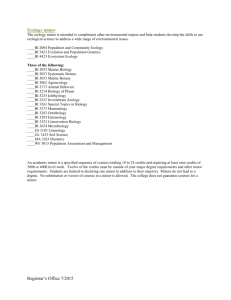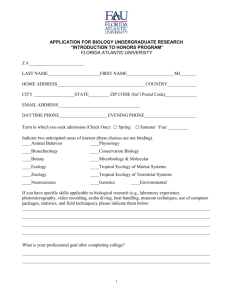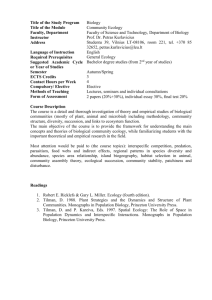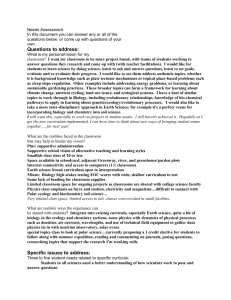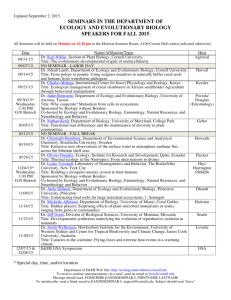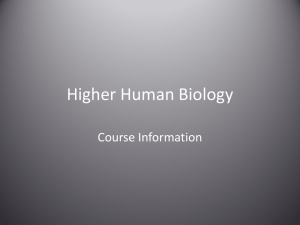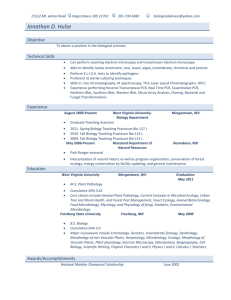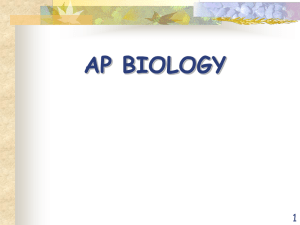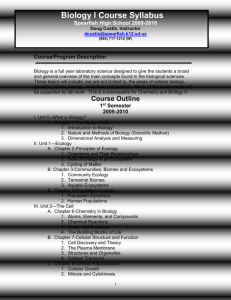Labs – 25% - Sharpsville Area School District
advertisement
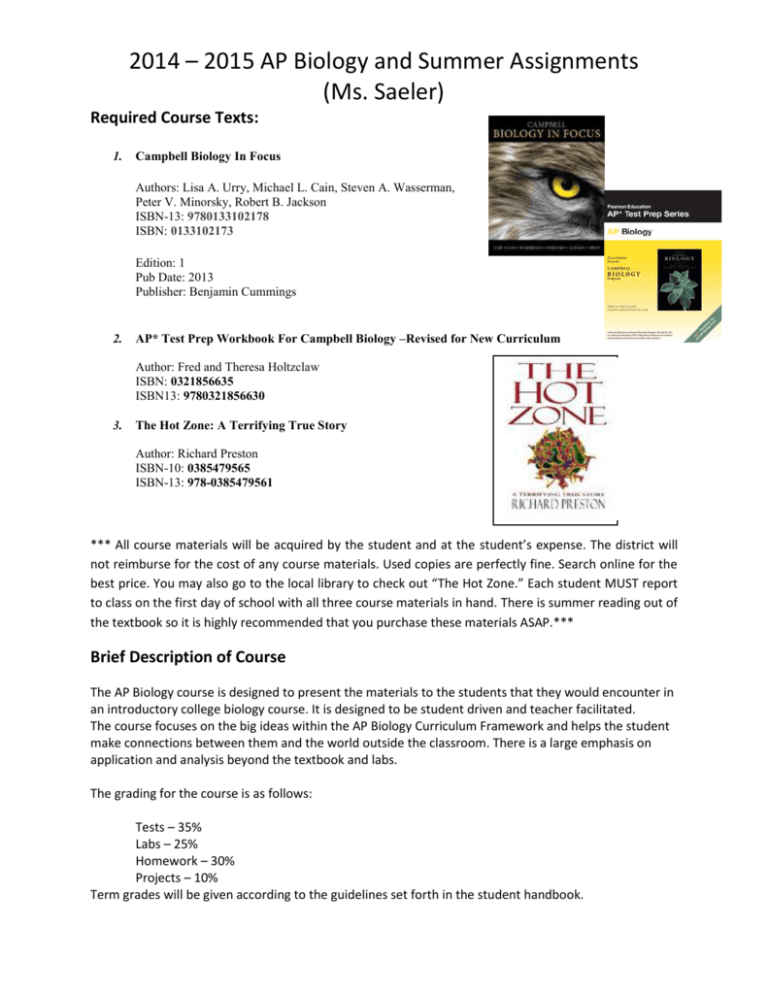
2014 – 2015 AP Biology and Summer Assignments (Ms. Saeler) Required Course Texts: 1. Campbell Biology In Focus Authors: Lisa A. Urry, Michael L. Cain, Steven A. Wasserman, Peter V. Minorsky, Robert B. Jackson ISBN-13: 9780133102178 ISBN: 0133102173 Edition: 1 Pub Date: 2013 Publisher: Benjamin Cummings 2. AP* Test Prep Workbook For Campbell Biology –Revised for New Curriculum Author: Fred and Theresa Holtzclaw ISBN: 0321856635 ISBN13: 9780321856630 3. The Hot Zone: A Terrifying True Story Author: Richard Preston ISBN-10: 0385479565 ISBN-13: 978-0385479561 *** All course materials will be acquired by the student and at the student’s expense. The district will not reimburse for the cost of any course materials. Used copies are perfectly fine. Search online for the best price. You may also go to the local library to check out “The Hot Zone.” Each student MUST report to class on the first day of school with all three course materials in hand. There is summer reading out of the textbook so it is highly recommended that you purchase these materials ASAP.*** Brief Description of Course The AP Biology course is designed to present the materials to the students that they would encounter in an introductory college biology course. It is designed to be student driven and teacher facilitated. The course focuses on the big ideas within the AP Biology Curriculum Framework and helps the student make connections between them and the world outside the classroom. There is a large emphasis on application and analysis beyond the textbook and labs. The grading for the course is as follows: Tests – 35% Labs – 25% Homework – 30% Projects – 10% Term grades will be given according to the guidelines set forth in the student handbook. The tests are structured in such a way as to prevent the simple memorization of material. Each test includes a variety of question formats in order to illicit higher order thinking to prove the students’ knowledge extends beyond memorization and reaches to the level of application and synthesis that is needed. The questions include multiple choice, essay, short answer, and graphical analysis formats. The wide variety of questions is used so that students can demonstrate their ability and knowledge in unknown situations. All laboratory investigations include pre-lab questions and write-ups in which the students must create a lab procedure which is pre-approved by the instructor prior to carrying it out in the lab. Once the students are in the lab they are to follow the procedure they created along with any other guidelines given by the instructor or in the lab. They are to pay particular attention to correct laboratory techniques and may lose points on the lab for not doing so. During the lab the students are required to record and keep data for analysis as part of the lab report. All lab reports are submitted with the following sections: 1. 2. 3. 4. 5. 6. 7. 8. 9. Title page Abstract Purpose and background Hypothesis Materials and safety Procedure Data tables Questions Discussion/summary The goal of the formal lab report is to emphasize the Seven Science Practices outlined for AP Biology. By requiring the students to create their own questions and lab procedures they are building the skills needed to make predictions, apply prior knowledge, analyze data and results, and then describe how their work connects to prior scientific discoveries and ideas in related disciplines. Handouts: Lab 1: Scientific Method – Seed Germination Lab topic 25: Ecology I: Terrestrial Ecology *3 copies of “Experimental Design Guide” *1 copy of the formal lab report scoring rubric – to be used by Ms. Saeler to grade all formal lab reports for the 2014-2015 school year *1 copy scientific method lab report guidelines – outlines what is expected in each section for each lab report. Refer to this throughout the school year to ensure that you are including all necessary parts of your lab report to maximize your score. I will use this to determine the grades on the scoring rubric which will be attached to the first page of all formal lab reports that have been grading. *1 copy of “Hot Zone” reading questions to accompany the outside reading to be completed as part of the final exam grade for the 2014-2015 school year *5 copies of ¼” graph paper (student may make additional copies as needed or graphs may be generated in a spreadsheet program such as Excel) *5 copies of the Cornell notes template. These will become more useful as readings from the book are assigned during the school year. These are never formally assigned but will help with understanding and retention of the material in the text. 1 copy of “Steps to Making and Appropriate Graph in Science Items with a * next to them indicates that a digital copy is available for student use upon request Lab materials for summer work: All lab materials provided to the student for use over the summer must be returned in good working order in the box in which the student received them the first week of school for the 2013-2014 school year. By taking the lab materials the students recognizes that he/she is responsible for the materials and agrees to pay the cost of replacement should the materials be lost, stolen, or broken while in the student’s possession. Some materials will not be required to be returned as indicated in the table below. Table A: Materials Needed and Provided to Complete Summer Investigations Item Seed(s) Miracle gro Plastic bag(s) Plastic cup(s) 10mL graduated cylinder(s) 25mL graduated cylinder(s) Metric ruler(s) Calipers Quantity 10 15g 5 5 1 1 1 1 Lab used in Lab 1 Lab 1 Both Lab 1 Lab 1 Lab 1 Lab 1 Lab 25 Must be returned? No Return container No Yes Yes Yes Yes Yes Table B: Materials Needed BUT NOT PROVIDED to Complete Summer Investigations Item Lab Used In Item Lab Used In Camera or other device to take pictures (phone is fine) Line, yarn, or twine both Rubber bands Lab 25 Lab 25 Lab 25 Center post (fat sticks work well) Mallet or hammer Measuring tape Paper towels Lab 25 Lab 25 Lab 25 Lab 1 Flags to mark plots (sticks and construction paper work well) Compass (find a free app) Index cards Permanent marker Lab 25 Lab 25 Lab 25 List of assignments: 1. Formal lab report for Lab 1: Scientific Method – Seed Germination Follow the instructions given with the lab for an exhaustive list of what is expected. 2. Formal lab report for Lab Topic 25: Ecology I: Terrestrial Ecology Follow the instructions given with the lab for an exhaustive list of what is expected. 3. Completed case studies: You will turn in a total of six (6) case studies on the first day. These types of readings will be assigned on a weekly basis throughout the school year. 4. Chapters 1, 2, 41 & 43 Cornell Notes (YOU WILL NEED YOUR TEXTBOOK!!!) 5. Chapters 1, 2, 41 & 43 following book problems/questions (YOU WILL NEED YOUR TEXTBOOK!!!): a. All “Concept Checks” b. All “Scientific Skills Exercises” c. All “Test Your Understanding” Questions There will be an exam on these 4 chapters the first day of school. Assignment due dates: 1. 3 case studies: July 11, 2014 a. One from each of the stacks as you received them on the day of our pre-summer meeting. 2. Formal lab report for Lab 1: Scientific Method – Seed Germination: July 11, 2014 3. All Cornell Notes: August 23, 2014 4. All book problems/questions: August 22, 2014 5. Formal lab report for Lab Topic 25: Ecology I: Terrestrial Ecology: August 22, 2014 6. Remaining 3 case studies: August 22, 2014
